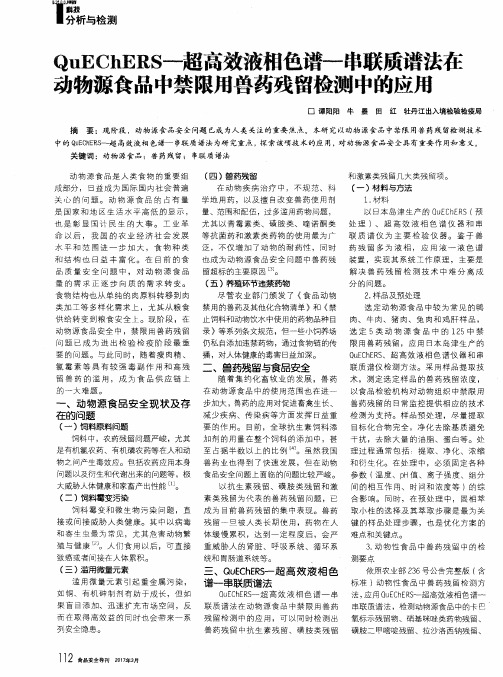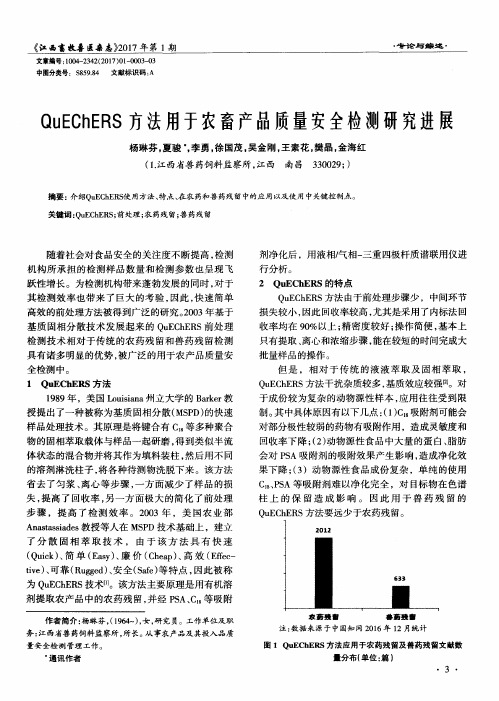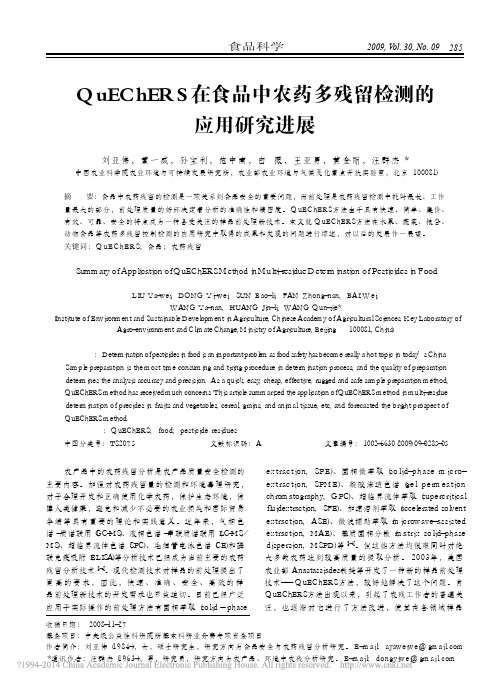奶粉中残留兽药的QuEChERS方法应用研究
- 格式:pdf
- 大小:357.74 KB
- 文档页数:5


QuEChERS方法及其在食品农药多残留分析中的应用袁雪婵(昆明理工大学生命科学与技术学院,昆明 650224) 摘 要:农药残留分析是分析化学中最复杂的领域,其原因主要是需分离和测定的残留农药量往往是在ng、pg甚至在fg级。
一次成功的分析需要有许多操作条件的正确结合和选择,尤其是萃取和净化方法的成功应用,传统样品前处理技术存在许多不足,如单个样品提取、净化时间较长,有毒溶剂消耗量大,给操作者及环境带来危害,现代样品制备技术正向着经济、节约、减少环境污染、微型化和自动化的方向发展。
2003年,由美国农业部农业研究服务中心的Anastassiades M,Lehotay SJ[1]等开发了一种快速、简便、价格低廉的预处理方法来实现高质量的农药多残留物分析方法—QuEChERS法。
QuEChERS是一种快速(Quick)、简便(Easy)、廉价(Cheap)、有效(Effective)、耐用(Rugged)、安全(Safe),用于检测食品中农药残留的前处理方法,该法采用含1%醋酸的乙腈提取,加入硫酸镁和氯化钠混合物促使其分层,上清液加入PS A和无水硫酸镁净化分离,最后加入分析保护剂进行GC/MS分析。
QuEChERS 法的平均样品添加回收率高于85%,干扰目标物检测的杂质少,溶剂用量小,操作简便、快速等特点,将是世界各国小型实验室常规检测农药多残留物的首选预处理方法。
关键词:QuEChERS;农药残留;样品前处理;研究进展中图分类号:S481+8 文献标识码:A 文章编号:1006-2513(2009)02-0144-05The advance of Q uEChERS i n the samp l e p re trea t m enttechni que s of pe sti ci de re si due s ana l yzeY UAN Xue2chan(Faculty of L ife Science and Technol ogy,Kun m ing University ofScience and Technol ogy,Kun m ing650224)Abstract:Pesticide residues analysis bel ongs t o the most comp lex areas of Analytical Che m istry,because the method of pesticide residues separati on and deter m inati on often need reach a certain level at ng,pg and even fg.A successful pesticide residues analysis requires the exact combinati on bet w een operating conditi ons and methods selecti on,es pecial2 ly refers t o the successful app licati on of extracti on and purificati on methods.Traditi onal p retreat m ent technol ogy of sa m2 p les has a l ot of disadvantages,for examp le,it need a l onger ti m e t o p retreat the samp les,and consu med a large quan2 tities of t oxic s olvents,mean while,itwill bring a great har m t o the operat ors and envir oment.Mordern sa mp le p repara2 ti on technol ogy devel op s t oward the directi on of ecnomy,saving,reducing envir omental polluti on,m iniaturizati on and aut omanti on.I n2003,Anastassiades M,Lehotay SJ etc by the United States Depart m ent of Agriculture Agricultural Research Service Center devel oped a fast,easy,cheap sa mp le p retreat m ent method t o achievve high-quality multi-residue pesticide analysis techniques,that is QuEChERS method.收稿日期:2008-09-22作者简介:袁雪婵(1982-),女,工学硕士,研究方向为生物化工专业、生物技术制药。

QuEChERS方法在食品安全检测中的研究进展陈刚1,邓晓军2*,陈舜胜1,赵善贞2(1. 上海海洋大学食品学院上海201306;2. 上海出入境检验检疫局上海200135)摘要:QuEChERS方法是近年来研发的检测蔬菜、水果等农药残留的前处理方法。
后来,随着该方法的不断发展,其应用的领域也愈来愈广泛。
本文简要介绍了QuEChERS方法的概述、相关应用以及其较传统方法的优势。
并指出目前所存在的不足和将来的发展趋势。
(引用文献58篇)关键词:QuEChERS;食品安全;检测Progress of QuEChERS method in the detection of food safety CHEN Gang1, DENG Xiao-jun2*, CHEN Shun-sheng1, ZHAO Shan-zheng2(1. College of Food Science and Technology, Shanghai Ocean University, Shanghai 201306, China;2. Shanghai Entry-Exit Inspection and Quarantine Bureau of The People's Republic ofChina, Shanghai 200135, China)Abstract: QuEChERS is a pretreatment method which is mainly used in the detection of pesticide residue of vegetables and fruits. With the continuous development of this method, its application field is more and more wide. This paper briefly introduces the overview of QuEChERS method, related applications and its advantages. The deficiency and development trend of the future are also be pointed out in this article. (58 ref. cited)Key words: QuEChERS;Food safety;detection近年来,食品安全问题日益受到人们的关注。


QuEChERS 在食品中农药多残留检测的应用研究进展刘亚伟,董一威,孙宝利,范中南,白 薇,王亚男,黄金丽,汪群杰*(中国农业科学院农业环境与可持续发展研究所,农业部农业环境与气候变化重点开放实验室,北京 100081)摘 要:食品中农药残留的检测是一项关系到食品安全的重要问题,而前处理是农药残留检测中耗时最长、工作量最大的部分,前处理质量的好坏决定着分析的准确性和精密度。
QuEChERS方法由于具有快速、简单、廉价、有效、可靠、安全的特点成为一种备受关注的样品前处理新技术。
本文就QuEChERS方法在水果、蔬菜、粮谷、动物食品等农药多残留控制检测的应用研究中取得的成果和发现的问题进行综述,对以后的发展作一展望。
关键词:QuEChERS;食品;农药残留Summary of Application of QuEChERS Method in Multi-residue Determination of Pesticides in FoodLIU Ya-wei,DONG Yi-wei,SUN Bao-li,FAN Zhong-nan,BAI Wei,WANG Ya-nan,HUANG Jin-li,WANG Qun-jie*(Institute of Environment and Sustainable Development in Agriculture, Chinese Academy of Agricultural Sciences, Key Laboratory ofAgro-environment and Climate Change, Ministry of Agriculture, Beijing 100081, China)Abstract :Determination of pesticides in food is an important problem as food safety has become really a hot topic in today’s China.Sample preparation is the most time consuming and tiring procedure in determination process, and the quality of preparationdetermines the analysis accuracy and precision. As a quick, easy, cheap, effective, rugged and safe sample preparation method,QuEChERS method has received much concerns. This article summarized the application of QuEChERS method in multi-residuedetermination of precides in fruits and vegetables, cereal, grains, and animal tissue, etc, and forecasted the bright prospect ofQuEChERS method.Key words:QuEChERS;food;pesticide residues中图分类号:TS207.5 文献标识码:A 文章编号:1002-6630(2009)09-0285-05收稿日期: 2008-11-27基金项目:中央级公益性科研院所基本科研业务费专项资金项目作者简介:刘亚伟(1984-),女,硕士研究生,研究方向为食品安全与农药残留分析研究。

奶粉中残留兽药的QuEChERS方法应用研究宓捷波;许迪明;李淑静;林安清;许泓【期刊名称】《食品研究与开发》【年(卷),期】2015(000)002【摘要】通过萃取溶剂和盐析剂等优化,改进了QuEChERS技术。
建立了奶粉中22种兽药残留检测的简捷、快速、特异性的QuEChERS-超高效液相色谱-串联质谱分析方法。
该方法通过EDTA和缓冲体系优化了磺胺、喹诺酮和四环素类药物的萃取检测过程,使磺胺、喹诺酮和四环素的检测低限达到1、5μg/kg和50μg/kg,添加回收率为70%~102%, RSD小于15%。
【总页数】5页(P121-125)【作者】宓捷波;许迪明;李淑静;林安清;许泓【作者单位】天津出入境检验检疫局动植物与食品检测中心,天津300461;宁波出入境检验检疫局,浙江宁波315000;天津出入境检验检疫局动植物与食品检测中心,天津300461;天津出入境检验检疫局动植物与食品检测中心,天津300461;天津出入境检验检疫局动植物与食品检测中心,天津300461【正文语种】中文【相关文献】1.检测水产品中兽药残留的QuEChERS方法应用研究 [J], 陈国栋;王颖2.QuEChERS-液相色谱串联质谱仪检测猪肉中102种农兽药残留及非法添加物方法的研究 [J], 贝峰; 路川; 王乐勇; 赵成新; 杜海云; 王超; 李建亮; 周杨学; 聂梅3.探究农兽药残留检测中的QuEChERS方法 [J], 王涛; 李明杰4.QuEChERS结合超高效液相色谱串联质谱在动物源性食品兽药残留分析中的应用研究 [J], 李红丽5.QuEChERS结合超高效液相色谱串联质谱在动物源性食品兽药残留分析中的应用研究 [J], 李红丽因版权原因,仅展示原文概要,查看原文内容请购买。
探讨QuEChERS 方法在食品农兽药残留检测中的应用作者:曹俊杰,于霞,胡畔来源:《现代食品》 2018年第23期摘要:近年来,食品安全问题日益增多,严重威胁着人体的健康。
农兽药是食品中常见的残留污染物,本文首先简要介绍了QuEChERS 方法,然后重点探究该方法在在食品农兽药残留检测中的应用。
关键词:QuEChERS 方法;农兽药残留;药物检测食品安全问题是世界各国十分重视的热点问题,其中,农兽药残留量是食品中主要的污染源之一。
因此,QuEChERS 方法应运而生,其优点是快速(Quick)、简单(Easy)、廉价(Cheap)、有效(Effective)、可靠(Rugged)及安全(Safe),该方法提高了检测食品的效率,也避开传统检测方法繁琐的处理步骤。
QuEChERS 方法能够弥补传统检测方法的不足,基于此,本文针对QuEChERS 方法在食品农兽药残留检测中的应用展开探究。
1 关于QuEChERS 方法的分析1.1 QuEChERS 方法的概念QuEChERS 是一种新型的药物多残留样品处理方法[1],且具有简单、方便、经济实惠、安全可靠等优势,主要适用于各种水果、蔬菜、肉类、火锅底料等中的农兽药、罂粟碱检测。
近年来,研究学者对QuEChERS 方法细致分析,并逐渐扩大该方法应用范围,现如今,QuEChERS 方法已成为数百种农兽药残留检测的首选方法。
1.2 QuEChERS 方法的构成技术人员在建立QuEChERS 方法时,主要对3 种药剂进行选择,分别是提取剂、脱水剂和净化剂。
掌握QuEChERS 方法构成,能为QuEChERS 方法优势分析、QuEChERS 方法运用起到理论铺垫作用。
1.3 QuEChERS 方法的优势QuEChERS 方法的检测周期短,操作简单而且批量化,准确度和精密度较高,检测样品的可行性非常高;产生溶剂及废液较少,容器和器皿可以重复多次使用,不会造成资源浪费,同时能够减少应用成本;QuEChERS 方法便捷、快速、可靠和安全。
环保治理18畜牧业环境 2020.05摘 要:本文对QuEChERS法的应用优势与流程进行分析,并分别对方法在农药、兽药残留的检测方式加以阐述,力求通过本文研究,使农兽药中的残留得到准确检测,为食品安全提供强有力的技术支持。
关键词:农兽药残留;QuEChERS;应用方法1 QuEChERS方法概述随着人们物质生活质量的提升,对食品安全的重视程度不断提高。
部分食品中含有农兽药残留,对公众健康与环境污染产生较大不良影响。
现阶段,对食品中药物残留的检测方法众多,QuEChERS作为一种新型的处理方法,可有效应用到多类多残留样品中,且检测结果十分精准可靠。
1.1 操作流程该方法作为一种新型的药物残留制备法,具有简单方便、准确可靠、经济性、安全性等特征。
在应用过程中,主要分为三个步骤,第一步采用有机溶剂对高湿样品进行萃取,并将盐加入其中促进水与溶剂分离;第二步,对混合体系进行振摇与离心处理后,将其中部分有机相与吸附剂混合起来,采用分散固相萃取净化;最后,对混合物进行离心处理后,对上清液直接进行分析或者溶剂交换。
1.2 应用优势与以往的农药残留分析法相比,QuEChERS法具有诸多优势,具体如下:一是回收率较高,针对挥发性较强、检测难度较大的农药,其回收率可超过85%;二是样品通量较高,可在30~40min之内完成10~20个预先称重样品的检测,在检测过程中对操作者自身技术水平要求不高,且每个样品可反复使用同一个器皿,操作方法简单方便;三是在萃取净化的同时,食品中的脂肪酸与其他有机酸被剔除;四是该方法经济性较强,每10g样品中只需1美元的药品,且在样品制备中采用的设备类型较少,只需粉碎机、离心机与天平即可。
2 QuEChERS在农兽药残留检测中的应用2.1 农药残留检测2003年,QuEChERS法首次在果蔬农药残留中进行应用,该方法操作便利、经济性强,为了开展深层次的探究,专家学者陆续将该法应用到十余种不同食品的检测之中。
Jan. 2022 CHINA FOOD SAFETY 101分析检测QuEChERS 法用于动物源性食品中多种β-受体激动剂残留量测定王 丹,谷翠梅,李 勤(潍坊市疾病预防控制中心检验科,山东潍坊 261061)摘 要:目的:建立QuEChERS-超高效液相色谱三重四级杆法测定动物源性食品中β-受体激动剂。
方法:使用QuEChERS 前处理方法,采用UPLC-MS/MS 分析技术。
经过QuEChERs EMR-Lipid 法处理过的β-受体激动剂类药物在1.0~10.0 ng/mL 的线性关系良好,r 为0.942~0.999,回收率为58.5%~89.2%,RSD 为 3.10%~17.11%,检出限为0.03~0.10 μg/kg ,定量限为0.1~0.3 μg/kg 。
结论:QuEChERs EMR-Lipid 法,能有效提取目标物,过程简单,节约了试剂和时间成本,各项指标也均满足相关法规的要求,且试验的重现性令人满意,可以作为本次研究动物源性食品中β-受体激动剂残留量的检测方法。
关键词:超高效液相色谱/串联质谱法;动物源性食品;β-受体激动剂QuEChERS Method for Determination of Residues of Variousβ-receptor Agonists in Food of Animal OriginWANG Dan, GU Cuimei, LI Qin(Weifang Center for Disease Control and Prevention Clinical Laboratory, Weifang 261061, China)Abstract: Objective: To establish a QuEChERS-ultra performance liquid chromatography triple quadrupole for the determination of ß-agonists in animal-derived foods. Method: Using QuEChERS pre-treatment method and UPLC-MS/MS analytical technique. Result: The β-receptor agonists treated by QuEChERs EMR-Lipid method had a good linear relationship in the range of 1.0 ~ 10.0 ng/mL, the r was 0.942 ~ 0.999, the recovery was 58.5% ~ 89.2%, and the RSD was 3.10% ~ 17.11 %, the detection limit was0.03 ~ 0.10 μg/kg, and the quantification limit was 0.1 ~ 0.3 μg/kg. Conclusion: QuEChERs EMR-Lipid method can effectively extract target compounds, the process is simple, the cost of reagents and time is saved, and all the indicators meet the requirements of relevant regulations, and the reproducibility of the experiment is satisfactory. It can be used as a method for the determination of β-agonist residues in animal-derived foods in this study.Keywords: Ultra Performance Liquid Chromatography/tandem Mass Spectrometry; food of animal origin; β-agonists基金项目:2018年潍坊市卫生计生委科研项目(wfwsjs _2018_028)。